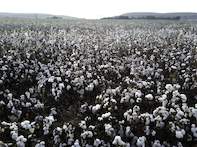Before the use of genetically modified cotton (GM cotton) types, cotton production was associated with low yields (due to weed competition and pests like bollworm) and high usage of pesticides with the subsequent destructive impact on the environment.

A strategy to improve yields, reduce reliance on pesticides and prevent the killing of cotton plants when spraying for weeds, needed to be developed.
Genetic modification (GM cotton) of certain parts of the cotton plants DNA was done to develop technology that enhances the cotton farming to the industry that supplies 38% of the world’s fibre. Genetically modified cotton (GM cotton) was introduced in the US in 1996 and in India in 2003.
Types of GM Cotton
Genetically engineered cotton (also called genetically modified cotton or GM cotton) is engineered with one of two traits. One modification makes cotton resistant to glyphosate-based herbicides (weedkillers) such as Roundup. This means weeds can be sprayed and killed without damaging the growing cotton.
The second genetic modification is Bt cotton. This is an insect-resistant crop that produces a toxin that kills the bollworm, one of the cotton’s main pests. This bollworm-resistant cotton is engineered with a gene from the bacteria Bacillus thurengiensis or ‘Bt’.
Bt cotton was created by genetically changing it to produce a protein normally produced by the bacteria. The Bt cotton plant then is able to produce toxic crystals that, when the bollworm feeds on the plant, would kill the bollworm.
It is important to understand that Bt cotton underwent stringent tests and does not harm non-target insects like bees, states Dr Annette Bennett, technical manager of Cotton SA.
Researchers developed Bt cotton and it was commercially released in China and the US in 1996 and in India in 2003. Bt cotton is the more commonly grown of the two types of GM cotton.
Bt cotton has reduced the use of pesticides by 50% and increased yields due to reduced bollworm losses. It also leads to an increase in cotton production in various countries including Burkina Faso (an 1153% increase in hectares planted) as well as South Africa (17%).
By Marinda Louw